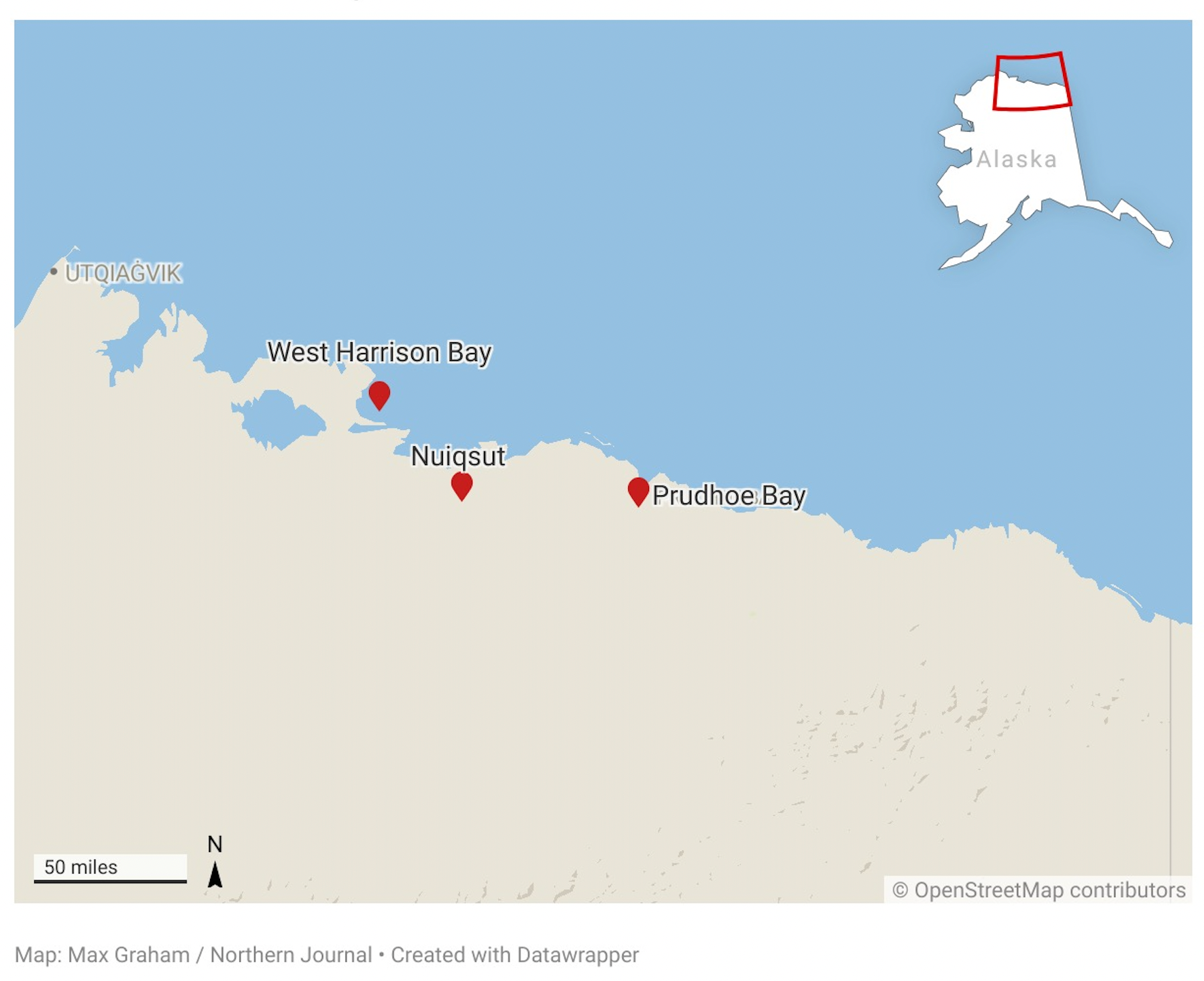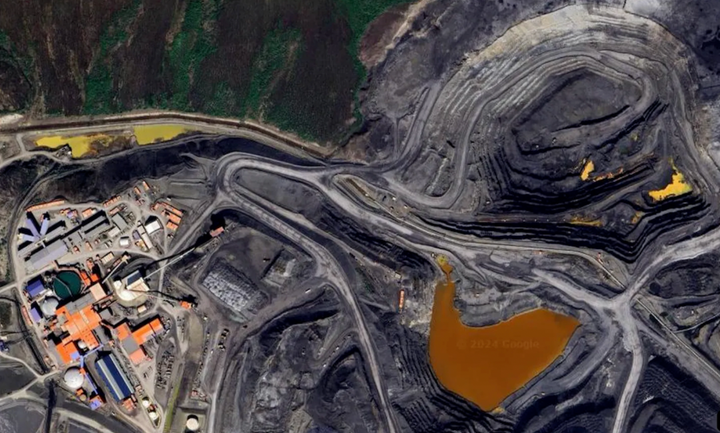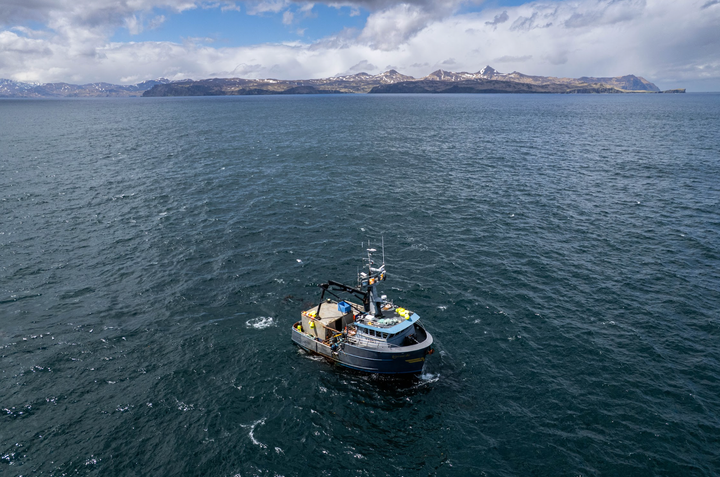A small Texas firm is gearing up for a $150 million search for oil beneath the Arctic Ocean
Narwhal Exploration is one of three small, privately owned companies with offshore leases in West Harrison Bay, a promising but largely unexplored area once controlled by Shell.

Northern Journal is a reader-funded publication; nearly all of our income comes from $100-a-year and $10-a-month contributions from voluntary members. Join if you can; if you're already a member, thank you.
Last year, one of the world’s biggest oil companies walked away from a handful of promising leases in shallow waters just off the coast of Alaska’s North Slope.
The move by Shell, which some observers attributed to pressure from the company’s climate-conscious investors, raised questions about the future of oil development in the Arctic, particularly in more expensive and technically challenging areas offshore.
Companies can drill wells more cheaply, and with less environmental opposition, in parts of the Lower 48. If a deep-pocketed player like Shell wasn’t going to invest the hundreds of millions of dollars needed to search for oil on remote North Slope oil prospects, who would?
The answer, it now appears, is a company that’s nothing like Shell: Narwhal Exploration, a small, Texas-based firm.
Narwhal, whose officials did not respond to requests for comment, has been quietly gearing up for what industry observers describe as one of the industry’s most intriguing drilling efforts in recent years.
This winter, the company plans to sink as many as five exploration wells into state land beneath West Harrison Bay — a shallow inlet of the Beaufort Sea.
The effort targets an oil-rich geologic formation, the Nanushuk, that had been mostly disregarded by the industry until a decade ago. That’s the same oil deposit being tapped by two huge onshore oil fields already under construction: ConocoPhillips’ Willow project and Santos’ Pikka project.
The closest community to Narwhal’s leases, the Iñupiaq village of Nuiqsut, is some 30 miles south.
Narwhal’s plans signal a notable step toward development in a remote area that geologists have long thought could hold huge reserves, but that has seen little exploration. It would be the first company ever to drill in West Harrison Bay.
A discovery there could be “sizable,” said Pete Stokes, an Anchorage-based, private sector petroleum engineer and consultant who spent years evaluating oil prospects on the North Slope — including, at one point, West Harrison Bay.
“I think there’s probably something there,” said Stokes. “The question would be how big a discovery it is and whether it can be economically developed.”
Narwhal’s search for oil could cost some $150 million, according to the website of a Florida-based private equity group that’s helping the company raise money.
West Harrison Bay has garnered interest from the oil industry for more than a decade. Shell acquired its leases there in 2012, while Narwhal — whose exploration manager and chief operating officer used to work for Shell — purchased neighboring leases in 2016.
“It’s an area that we’ve been real eager to see somebody do some exploration on,” said Derek Nottingham, director of the Alaska Division of Oil and Gas.
Despite reports of favorable geologic data, including promising results from decades-old wells drilled nearby, Shell never conducted any major exploration work in West Harrison Bay. The company cited an inability to find a suitable co-owner to share some of the costs.
Narwhal told state regulators in 2022 that it had made several offers to buy Shell’s leases, or to form a drilling partnership. But the energy giant never agreed.
Narwhal officials grew impatient: During a state legislative hearing last year they publicly criticized the commissioner of the state natural resources department for being “unwilling to hold Shell accountable” for not drilling on its leases or selling them.
A few weeks after the hearing, Shell announced that it was relinquishing its leases.
In a state auction last fall, a Narwhal affiliate called EE Partners and another privately owned company, Juneau Oil and Gas, collectively spent almost $9 million buying up the remaining tracts in West Harrison Bay — including Shell’s former holdings.

Juneau Oil and Gas, which outbid EE Partners on a number of parcels, has not informed the state oil and gas division of any plans to drill wells on its leases this winter, said Sean Clifton, an agency spokesperson.
The company, which didn’t respond to a request for comment, mainly focuses on prospects in the Gulf of Mexico, according to its website. But its manager, Brad Juneau, has ties to Alaska: He helped co-found Contango Ore, which holds several mining prospects in the state and owns a stake in the large-scale Manh Choh gold mine, near the Interior town of Tok.
Even if a company made a big discovery in West Harrison Bay, the infrastructure needed to start producing oil would take years to develop, given the logistical hurdles involved with getting it to market.
The leases in the bay are on submerged lands owned by the state of Alaska, whose more flexible permitting regime could allow development to move more quickly than in nearby federally managed areas like the National Petroleum Reserve-Alaska, according to industry observers. Development on state land also would give Alaska a greater share of royalty payments.
Drilling in West Harrison Bay would be closer to shore and shallower than at the far offshore prospect that Shell unsuccessfully drilled in the Chukchi Sea a decade ago. Other companies have successfully developed near-shore prospects on the North Slope.
Still, West Harrison Bay is “really remote,” said Nottingham. “There are some distinct logistical challenges in exploring, developing and producing that area.”
Building an oil field there could cost more than $8 billion, according to an estimate cited by Narwhal in a 2024 filing with state regulators. That’s roughly the amount ConocoPhillips is spending to develop Willow and more than double Santos’ construction costs at Pikka.
Narwhal has so far released few details about this winter’s drilling plans to regulators or the public. In various state and federal permit applications, it has outlined plans for summer field work, including sonar studies to help determine precise drilling locations.
The Center for Biological Diversity, a conservation group, raised several concerns about the impacts of oil exploration in West Harrison Bay in a June letter responding to Narwhal’s application for a permit under the federal Marine Mammal Protection Act.
The project “threatens the survival of threatened and endangered ice seals, bowhead whales, and other Arctic wildlife,” the group said in that 10-page letter.
The permit, which federal regulators ultimately granted, allows Narwhal to disturb 20 bowhead whales and more than 2,000 seals.



